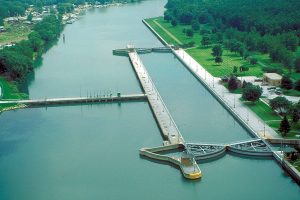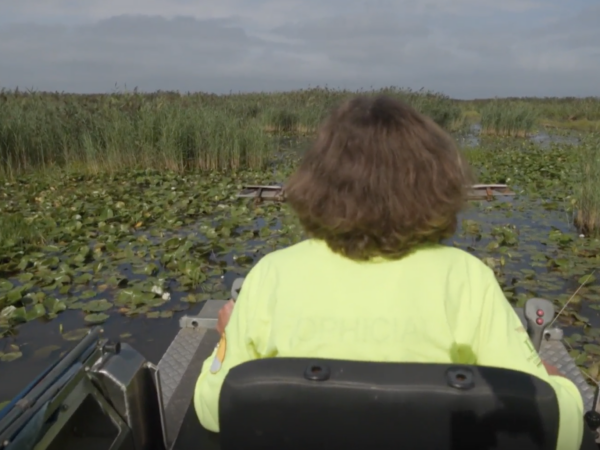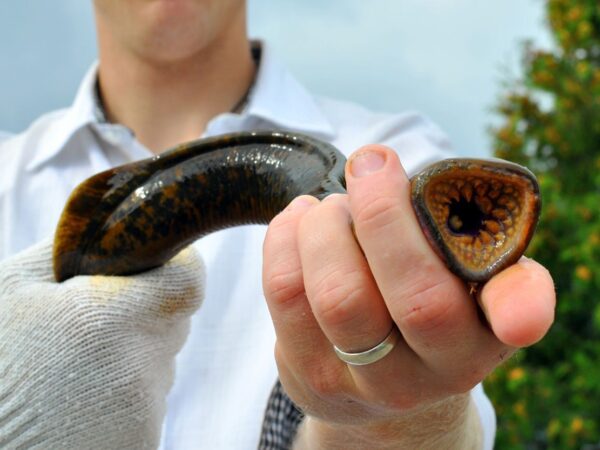
The autopsy is over. But what did we learn?
On June 22nd, a silver carp was discovered 9 miles from Lake Michigan in the Little Calumet River of the Chicago Area Water Way System.
It sent shockwaves throughout the Great Lakes Region and raised new fears about the effectiveness of the barrier defense system which has been in place since 2002 to try to prevent the invasive species from getting in to Lake Michigan and potentially invading all five Great Lakes.

T.J. O’Brien Lock and Dam on the Calumet River, courtesy of Carol Arney
The live capture in June just below the T.J. O’Brien Lock and Dam sparked an immediate response: two weeks of intense sampling in the area, including electrofishing and contract netting across more than 13 miles of the Calumet River, Little Calumet River and Calumet Harbor.
More than 20,000 fish were captured, but no additional bighead or silver carp were discovered.
Now, the autopsy of the silver carp caught in June has been released.
It was performed by Southern Illinois University, the U.S. Fish and Wildlife Service and The U.S. Geological Survey.
Here’s what we know: the silver carp was a male. It was 4 years old. It spent a quarter of its life in the Des Plaines River watershed.
But no one seems to know how it got above the barrier defense system – which has a system of volts strong enough to stop a human heart – to swim closer to Lake Michigan and raise the potential of invading the Great Lakes.
The scientists who did the autopsy say the fish spent anywhere from a few weeks to a few months in the stretch of river where it was discovered.
Is that good news? “No”, according to National Wildlife Federations Drew Youngdyke. He tells Great Lakes Now, “They only found one. That’s the only good news.”
He says the discovery and the results of the autopsy prove that “Clearly our current defenses are not enough.” He says the recommendations from the recent Army Corps of Engineers plan for Brandon Road is the best solution possible at this point.
The new study from the U.S. Army Corps of Engineers suggests building multiple structural impediments near the Brandon Road Lock and Dam in Illinois to keep the fish from escaping the Mississippi River system and swimming into the Great Lakes.
They include an underwater noise-making system, an electric dispersal barrier to stun the fish, and the use of fish killing chemicals.
Boats that pass through the barrier would also be shot with water jets to remove fish from their hulls.
The cost: $275 million dollars.
Midwest deputy regional director for the U.S. Fish and Wildlife Service Charlie Wooley says the carp caught in June could have hatched anywhere along a roughly 200-mile stretch of the Illinois River before migrating northwest just 9 miles from the lake, where a fisherman landed it.
He says the only way the carp could have gotten there was to somehow evade three barriers in the Chicago Sanitary and Ship Canal about 37 miles from Lake Michigan. But no one seems to know how that happened.
In a statement released to Great Lakes Now, U.S. Senator Debbie Stabenow co-Chair of the Senate Great Lakes Task Force, says, “This is the first time that a live Silver carp has been found this close to Lake Michigan. Now, we have proof that it went through the Brandon Road Lock and Dam. Time is of the essence to both implement a permanent solution and take immediate steps to stop Asian carp from reaching our Great Lakes.”
The term “ Asian Carp” generally refers to 4 separate species: silver, big head, black and grass. What scientists fear most is the effects of the these fish on the Great Lakes food web.
Tory Gabriels, Extension Program Leader and Fisheries Educator for Ohio Sea Grant tells Great Lakes Now: “If silver and big head carp get into the Great Lakes, they have the potential to take food from all other organisms and severely deplete the 7 billion dollar Great Lakes fishing industry. “
But Illinois governor Bruce Rauner’s administration opposes the Brandon Road plan, saying it’s too costly for state taxpayers.
Illinois Governor Evelyn Sanguinetti calls the Brandon Road study an “unnecessary experiment”.
Most representatives of the shipping industry are opposed to the Army Corps of Engineers Brandon Road study because it could slow down commerce.
The Alliance for the Great Lakes, a Chicago-based environmental group, says the new carp autopsy results mean that any “stalling or obstructionism” by the Illinois government to stop construction of the Army Corps of Engineers improvements “will clearly be placing all of the Great Lakes at significant risk.”
2 Comments
-
Isn’t it possible that some human, either stupidly or maliciously, transported it beyond the barrier?
-
I had that SAME exact thought!!! So, my question is now, are there regulations in place to fine/imprison such an offender? If not, there should be!!!




